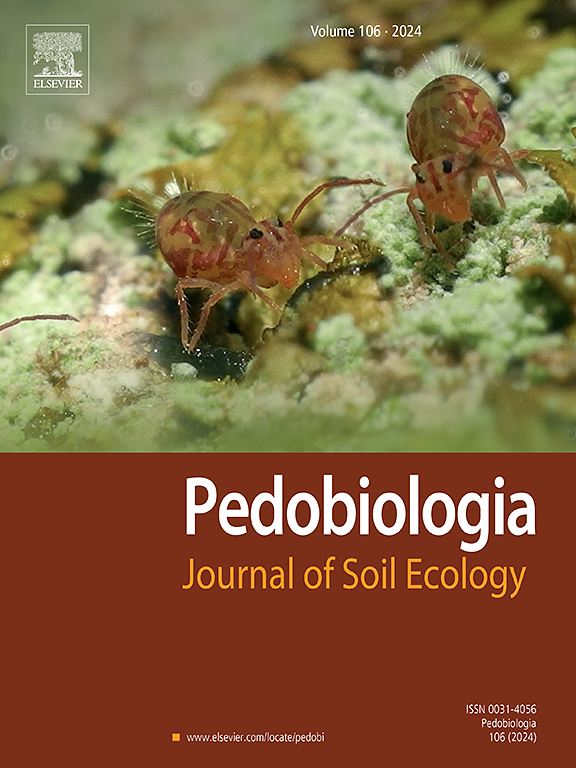A field mesocosm method for manipulation of soil mesofauna communities and repeated measurement of their ecological functions over months to years
IF 2
3区 农林科学
Q3 ECOLOGY
引用次数: 0
Abstract
In situ manipulation of mesofauna communities is necessary to understand their functional importance in complex natural systems. Field mesocosms that control the recolonization of defaunated soil and litter by mesofauna are well suited to this purpose, but are infrequently used and can produce undesirable side effects on microclimate. Here, we present an inexpensive and easy to construct field mesocosm design that is intended to address some limitations of existing mesocosm methods. Our mesocosms were engineered to manipulate mesofauna communities over one or two years via mesh treatments (21 µm, 41 µm, and 1000 µm mesh opening sizes) while minimizing mesh treatment side effects and allowing repeated access to mesocosm interiors for measurement of microclimate differences and mesofauna functions through time. They are also compatible with LI-COR survey chambers, enabling measurement of gas flux from mesocosms. We tested these mesocosms in untreated and thinned/burned ponderosa pine (Pinus ponderosa) forests in Valles Caldera National Preserve, New Mexico, USA to compare their performance in differing abiotic and biotic contexts. The mesocosm treatments successfully manipulated microarthropods > 150 µm for fifteen months but were only partially effective at manipulating microarthropods < 150 µm. This mesocosm technique advances our ability to disentangle the functional contributions of mesofauna in complex natural systems because it enables manipulation experiments with repeated sampling in time and space.
一种用于土壤中系动物群落操纵和数月至数年重复测量其生态功能的野外中系方法
为了了解它们在复杂自然系统中的功能重要性,有必要对中系动物群落进行原位操作。控制退化土壤和凋落物由中系动物再定殖的田间中生态系统非常适合这一目的,但很少使用,并且可能对小气候产生不良的副作用。在这里,我们提出了一种廉价且易于构建的场介域设计,旨在解决现有介域方法的一些局限性。我们的中生态系统经过设计,可以通过网格处理(21 µm, 41 µm和1000 µm的网格开口尺寸)在一到两年内操纵中生态系统群落,同时最大限度地减少网格处理的副作用,并允许重复访问中生态系统内部,以测量小气候差异和中生态系统的功能。它们还与LI-COR测量室兼容,可以测量来自中观宇宙的气体通量。我们在美国新墨西哥州的Valles Caldera国家自然保护区对这些中生态系统进行了测试,以比较它们在不同的非生物和生物环境下的表现。中膜治疗成功地操纵了微型节肢动物>; 150 µm 15个月,但对微型节肢动物<; 150 µm仅部分有效。这种中生态系统技术提高了我们在复杂自然系统中解开中生态系统功能贡献的能力,因为它允许在时间和空间上重复采样的操作实验。
本文章由计算机程序翻译,如有差异,请以英文原文为准。
求助全文
约1分钟内获得全文
求助全文
来源期刊

Pedobiologia
环境科学-生态学
CiteScore
4.20
自引率
8.70%
发文量
38
审稿时长
64 days
期刊介绍:
Pedobiologia publishes peer reviewed articles describing original work in the field of soil ecology, which includes the study of soil organisms and their interactions with factors in their biotic and abiotic environments.
Analysis of biological structures, interactions, functions, and processes in soil is fundamental for understanding the dynamical nature of terrestrial ecosystems, a prerequisite for appropriate soil management. The scope of this journal consists of fundamental and applied aspects of soil ecology; key focal points include interactions among organisms in soil, organismal controls on soil processes, causes and consequences of soil biodiversity, and aboveground-belowground interactions.
We publish:
original research that tests clearly defined hypotheses addressing topics of current interest in soil ecology (including studies demonstrating nonsignificant effects);
descriptions of novel methodological approaches, or evaluations of current approaches, that address a clear need in soil ecology research;
innovative syntheses of the soil ecology literature, including metaanalyses, topical in depth reviews and short opinion/perspective pieces, and descriptions of original conceptual frameworks; and
short notes reporting novel observations of ecological significance.
 求助内容:
求助内容: 应助结果提醒方式:
应助结果提醒方式:


